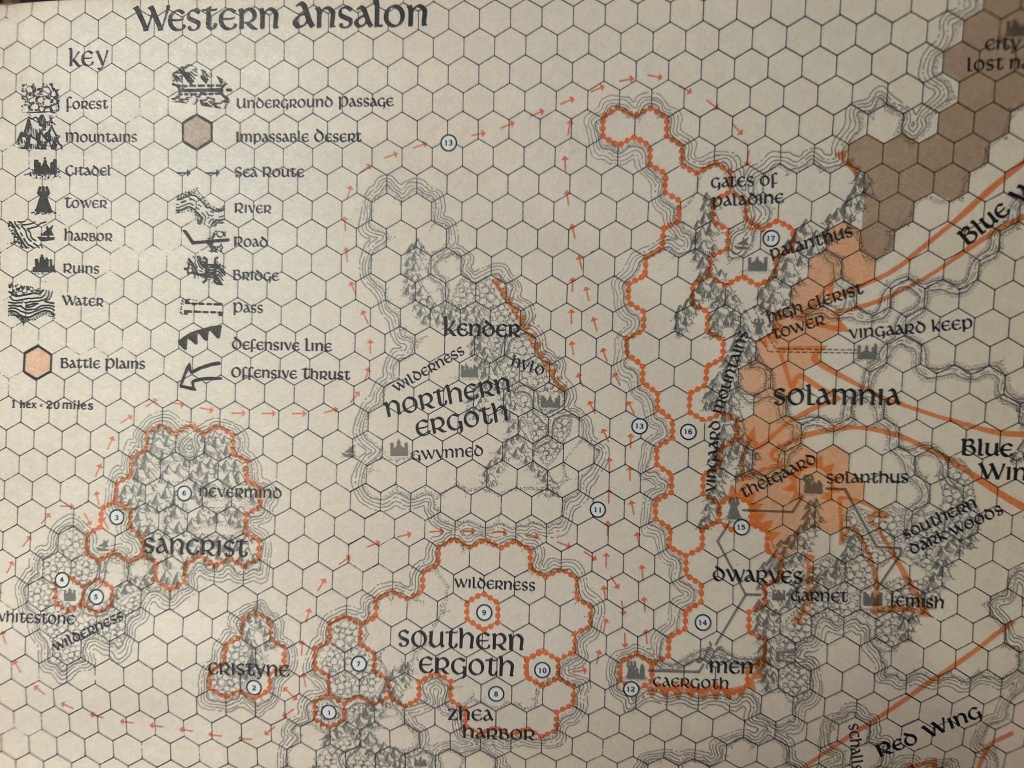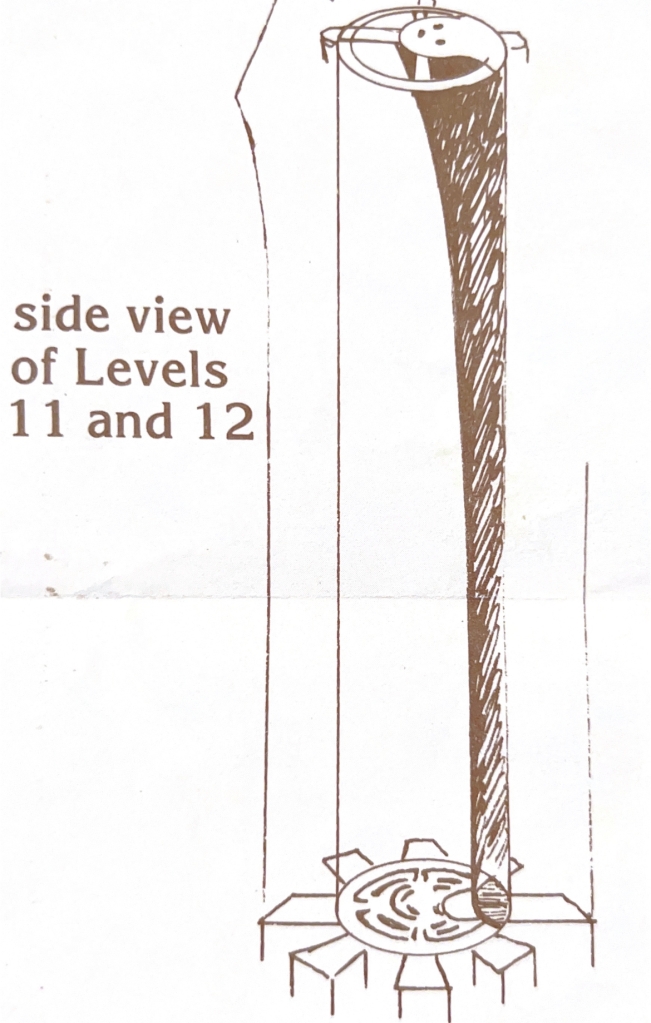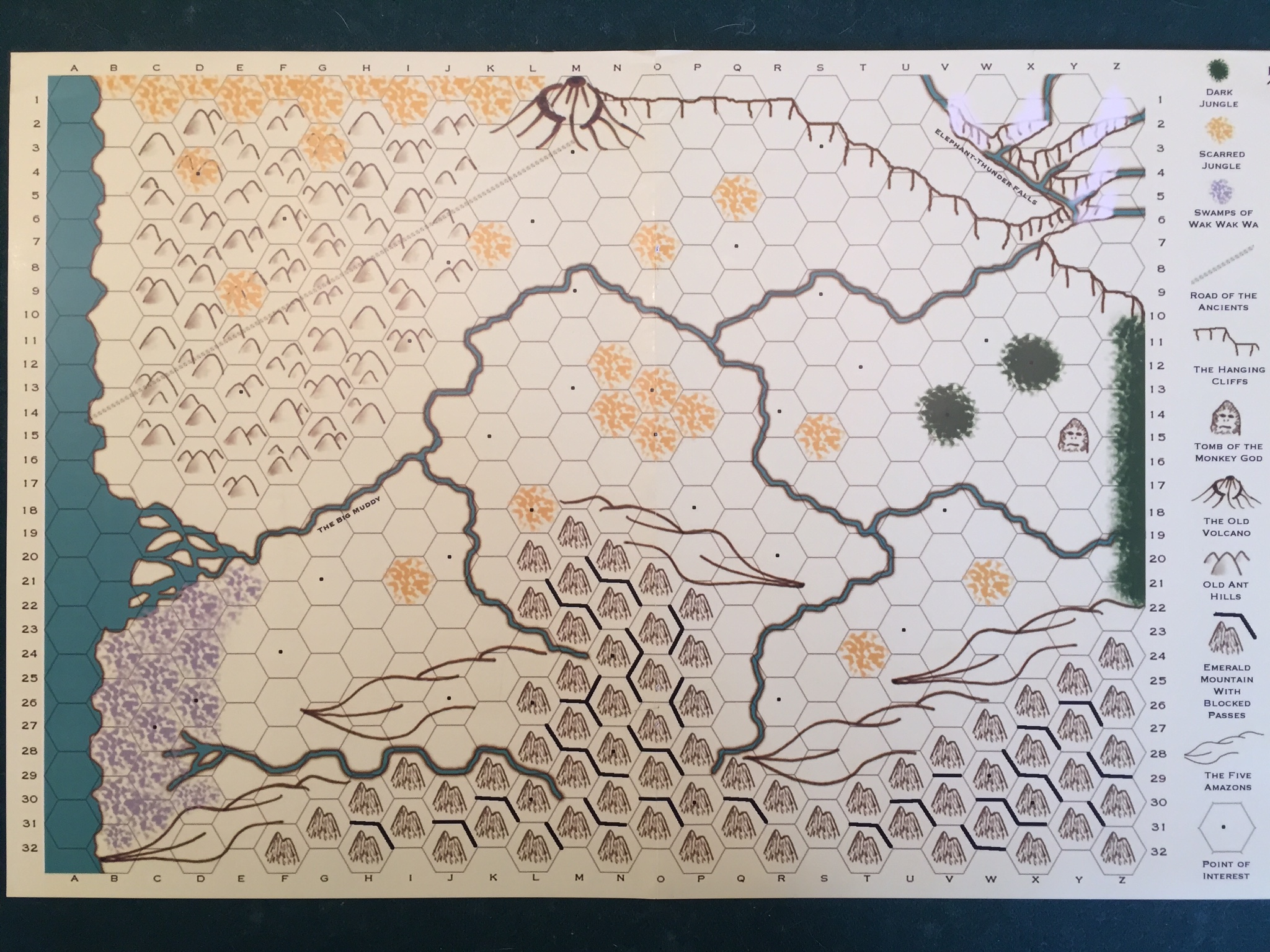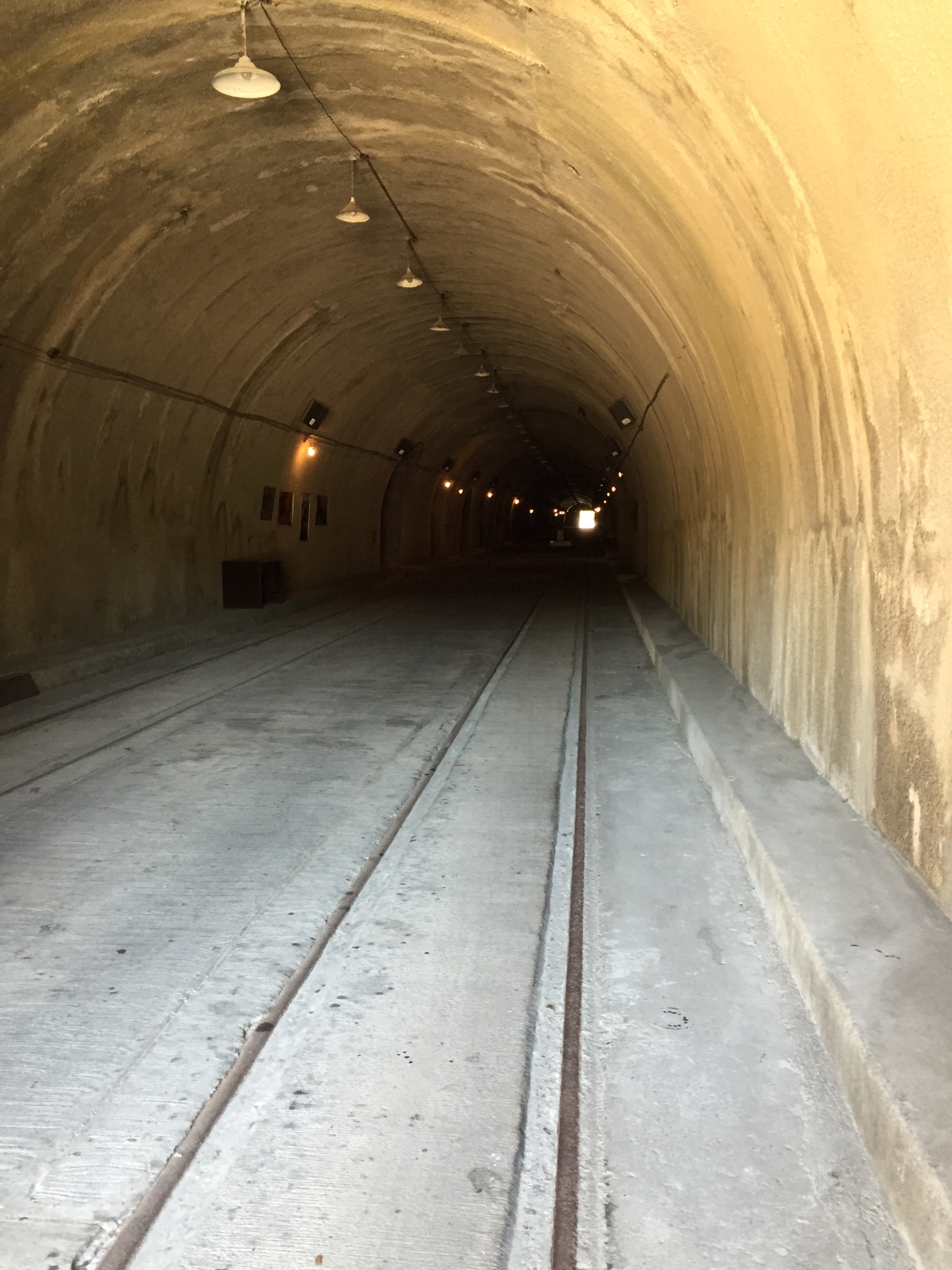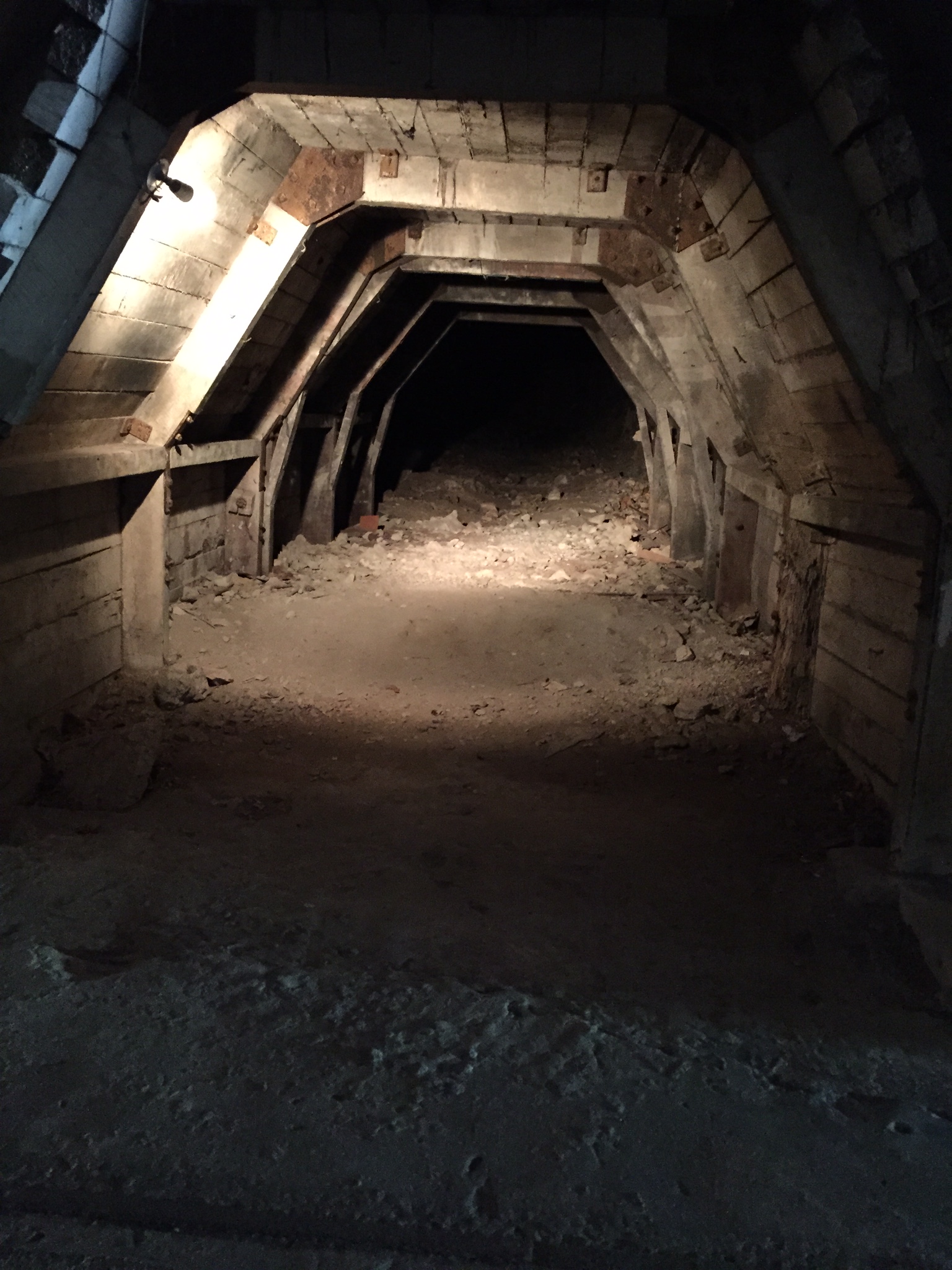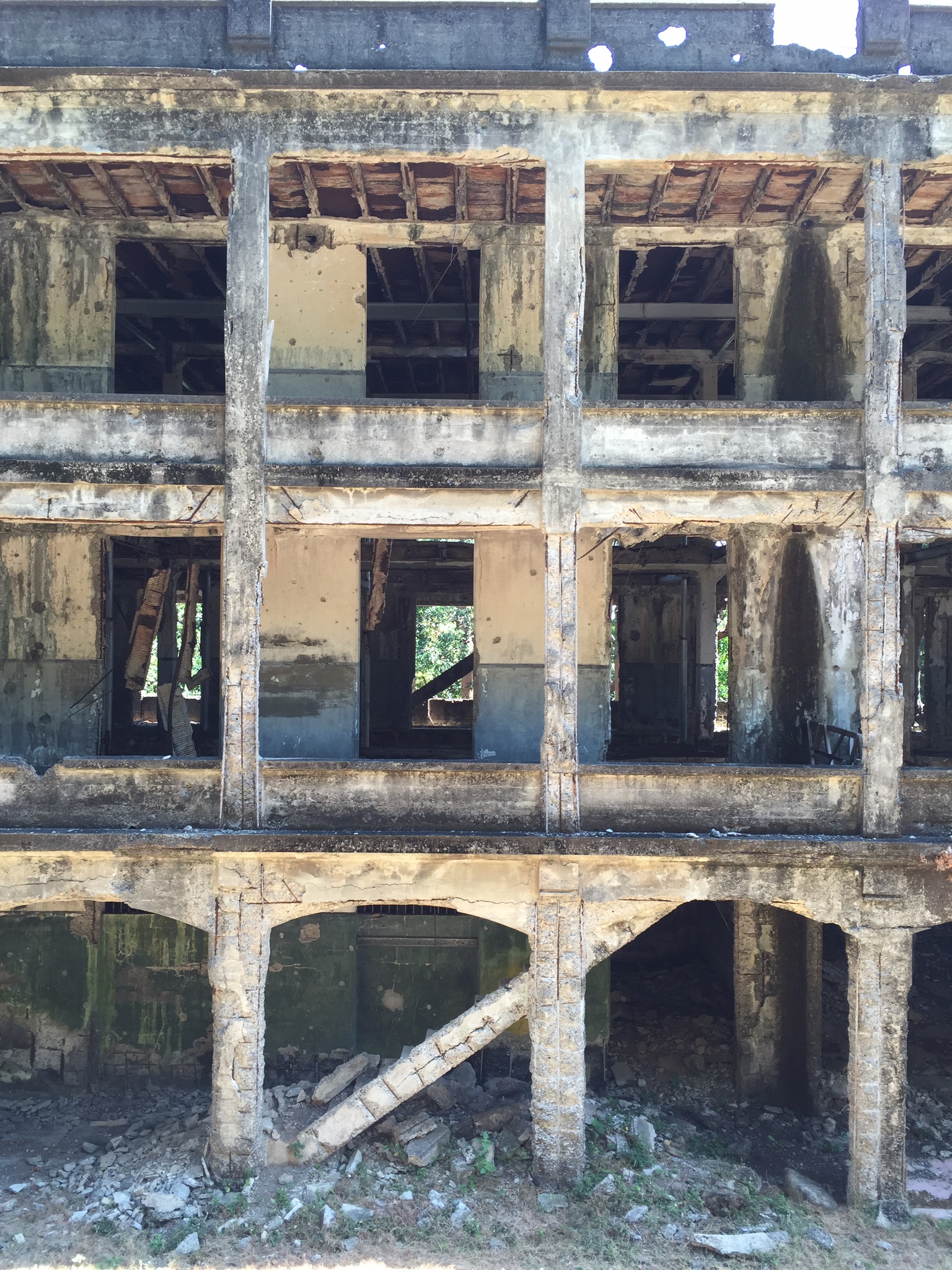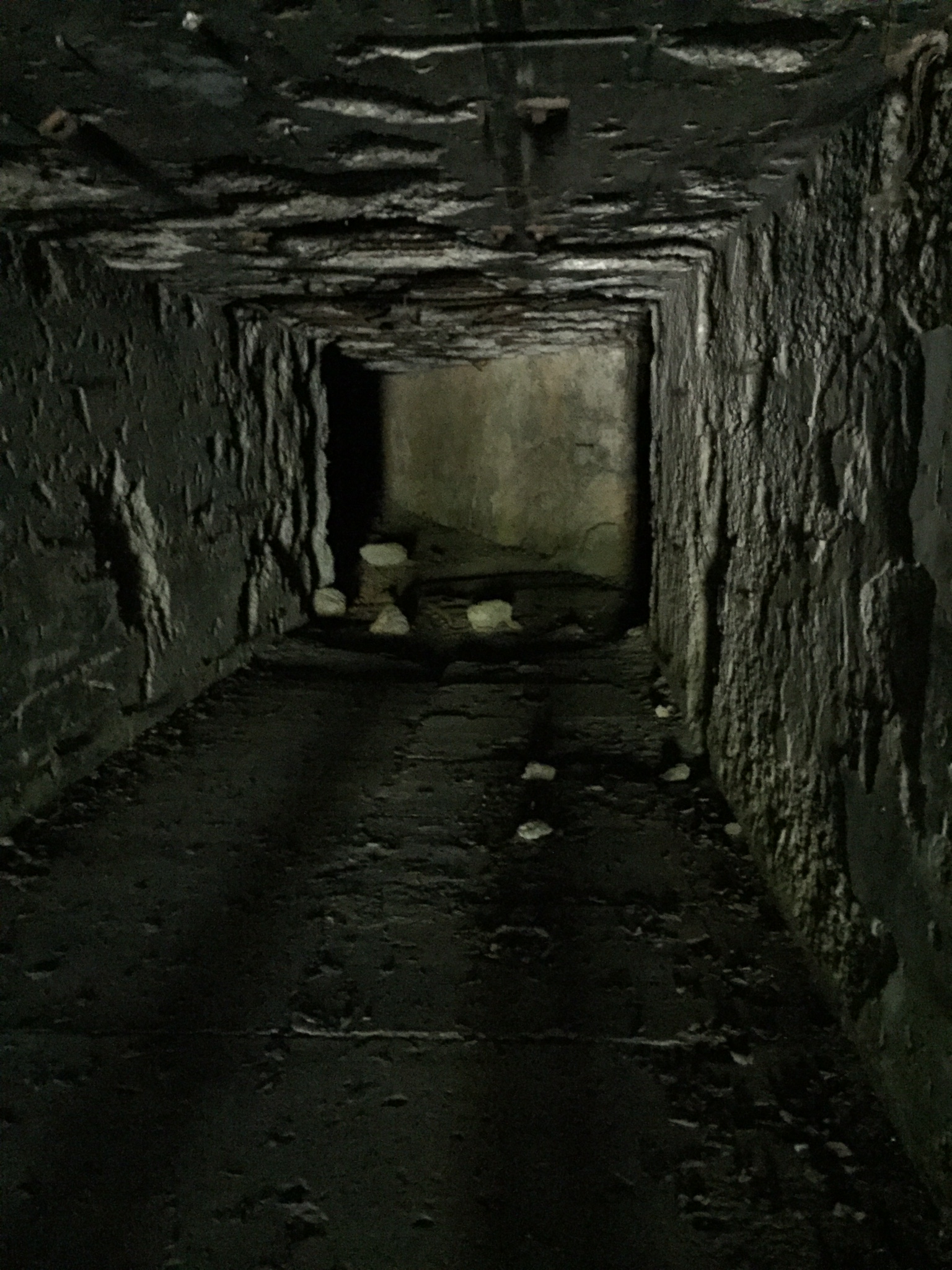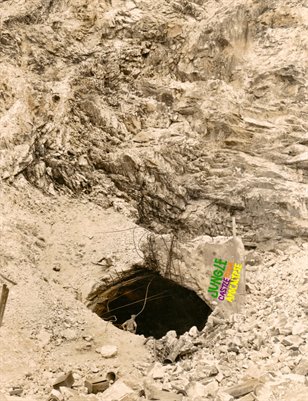Thieves don’t fight because they have better things to do
February 14, 2024
Last week, dwarves and elves. This week, The Arduin Adventure rulebook, on thieves:
Page 10:
“He accompanies adventurers to earn fame and loot and is the one who opens locked treasure chests, doors, and other enclosures. He almost never steals from his adventuring companions, and will fight only if it is desperately necessary.”
Page 11:
“THIEVES add one point each to their agility and dexterity. They also have a 30% chance of hiding in darkness and shadows.”
That’s it for thief skill mechanics in the book: hiding. Minimal, compared to any official version of D&D. It’s works as a baseline thief class that focuses on sneakiness. A skill applicable to a variety of adventure situations. Locks are mentioned, but no rules provided.
Sneaky, rarely fights, and doesn’t steal from the party? Sounds like a famous burglar: Bilbo Baggins…

The baseline 30% chance of successful hiding at 1st level is notable. Thieves in early D&D editions need to gain a couple levels to approach that skill chance. Some editions have race or stat bonuses to help close the gap, but typically 1st level D&D thief skills have such low chance of success that it disincentivizes usage. (An old post with a proposed solution) 30% seems about right for 1st level. That’s a 15+ on a d20.
Thus, in addition to hiding and sneaking, we use the 30% baseline chance for all thief skills, such as lockpicking and trap disarming. Want more? Preceding The Arduin Adventure, the original Arduin Grimoire trilogy elaborated on the gamut of thief abilities, including bonuses for demihumans and ability stats. With good stats, a 1st level demihuman thief can push a skill chance beyond 50%.
Treasure chests are a classic adventure element and I never tire of seeing them sprinkled throughout dungeons. We had success with them in DL8 Dragons of War. The Arduin Dungeon modules have chests all over the place, in many shapes and sizes. Usually locked and trapped. Lockpicking ought to be preferred over smashing or prying open a treasure chest. Raise the dungeon alert level (and chance of ambush) when the party is being noisy and leaving a trail of smashed chests and doors. It’s better to bring a thief.

Back to The Arduin Adventure page 10…a thief “will fight only if it is desperately necessary.”
So they do nothing during combat? What about the glorious backstab?
No. They have better things to do…
Sneak around for loot and secrets. Maybe bring that wimpy mage to help decipher weird runes.
Climb that idol and pry out its ruby eyes.
Disarm and unlock that treasure chest.
The party doesn’t need to kill every hoard guardian. Just have the warriors keep them busy long enough (maybe some parrying involved) for the thief to grab the treasure. Then everybody skedaddles.
If melee is raging and the thief discovers that the chest cannot be disarmed or unlocked, the party can consider withdrawing from battle.
Or decoy the monster to smash the treasure chest open for you, springing that nasty trap right in the beast’s face.
Or get a 2-for-1 deal by luring foes near the chest, then the wizard flings a Fireball, blasting the chest open and frying the monsters. That may damage the prize inside, but sometimes sacrifices must be made.
Tie trip wires along escape routes. Let the rest of the party know this is being done, of course. Maybe create a diversion out in the hall.
And so on. There’s much for thieves to do while the rest of the party is clashing with the enemy. Burglars gotta burgle.

Dwarves Grab Stuff and Elves Don’t Lie
February 9, 2024
Lately I’ve been preparing to resume our Arduin campaign originally started last summer. Trying to stick with the Arduin Adventure rulebook only, but dipping into the cornucopia of the Arduin Grimoire trilogy where Arduin Adventure is lacking. Sometimes making house rules, you know the drill.
One of the features I like in Arduin Adventure is how setting details are baked into the PC race descriptions and mechanics. For example, dwarf and elf PCs receive a bonus of +12 to select ability scores. No other PC race gets a larger bonus than that. Here’s the catch: roleplaying limitations…
Page 8:
“[Elves] never lie and will always repay a debt even if it takes a thousand years.”
Page 9:
“[Dwarves] love gold and precious things avidly, and each Dwarf has a 20% chance of simply grabbing any valuable without thinking.”
I love these. Rather than strictly limitations, I view them as fun and challenging roleplaying cues. As a player, try to minimize the drawbacks and use them cleverly for benefit. As DM, use them to spur action and introduce complications.
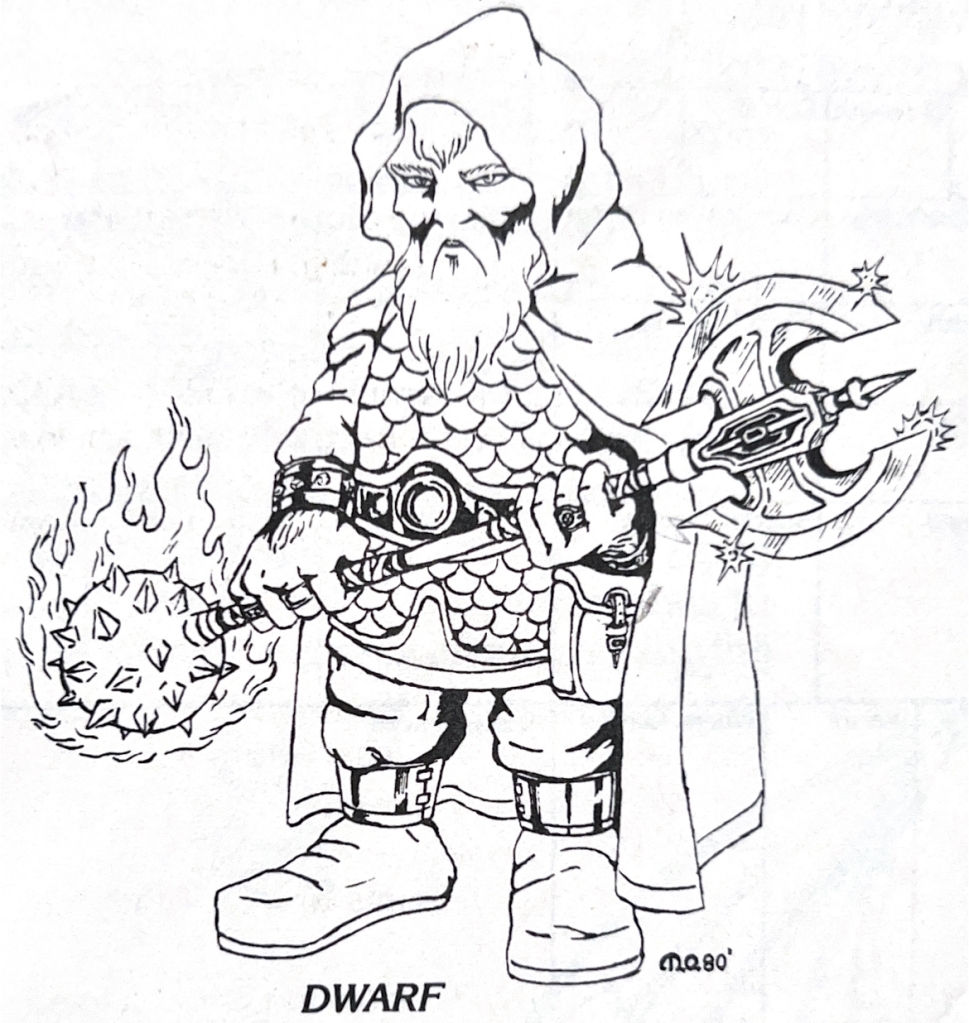
So sometimes dwarves grab valuables uncontrollably. Ok, seems like trouble waiting to happen. Notably, the trait doesn’t flat out prevent the dwarf from putting the valuable back where it was found, reluctantly, after the thrill of possession. Perhaps at the urging of friends. Perhaps at the convincing threats of the previous owner. The dwarf may try to avoid situations where the chance would present too much risk. For example, when a potentially cursed item is nearby. At other times, the dwarf may seek out situations to use the trait to their advantage.
In a world where dwarves are known for this behavior, they will be watched carefully. That could make dwarves good decoys. Sometimes a dwarf may not be compelled, but will intentionally grab a treasure, just to see what happens. And then play dumb. If they get caught: “So sorry about that…you know how dwarves are…all is forgiven?”
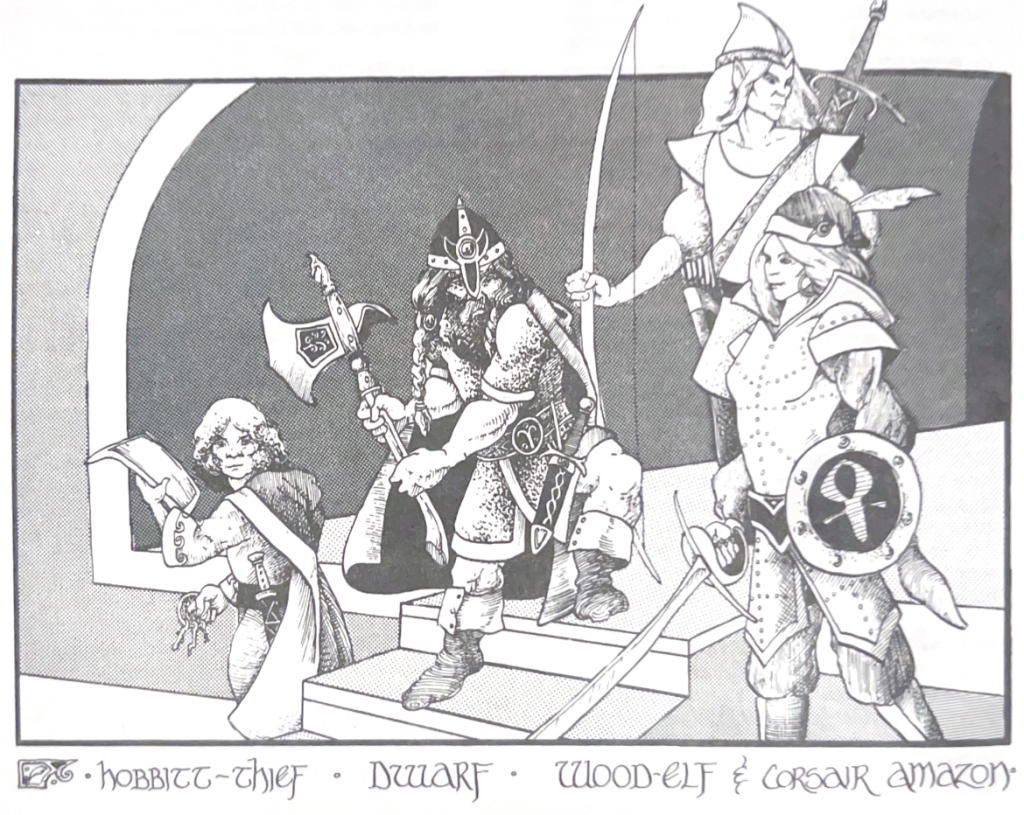
So elves never lie. That doesn’t mean they always tell the whole, plain truth. Sometimes they’ll say nothing at all. This can make an elf seem aloof, mysterious, evasive. Elves can use this trait to their advantage. Silence can be used deceptively.
Perhaps they tend to talk in riddle, metaphor, or allegory to obfuscate the truth or have multiple meanings. In that case, it’s up to the listener to decide what the truth is, and that decision may reveal more about the listener.
It’s not the first time Hargrave emphasized the notion of deception in his game. In the original Arduin Grimoire trilogy:
- The PC alignment chart has a “Lie Factor” for each alignment combination.
- One of the percentile thief abilities is LIE, the ”chance of successfully talking your way out of any situation in which you have been caught stealing, etc.”
- The stat blocks of monsters have “% Liar”. Some have a percentage, some are “too stupid to”, some “never lie”, etc.
That last one is famously connected to the infamous typo in the original D&D monster list: “% in Liar” instead of “% in Lair”.
I’m with Hargrave on this one: it’s more useful to know how often a monster is a LIAR, than to know if it’s in a LAIR. It’s an individualized roleplaying seed and supplement to reaction rolls. It makes explicit that monster encounters can often involve talking…and deception.
DL1: Straight to the Lost City
February 7, 2024
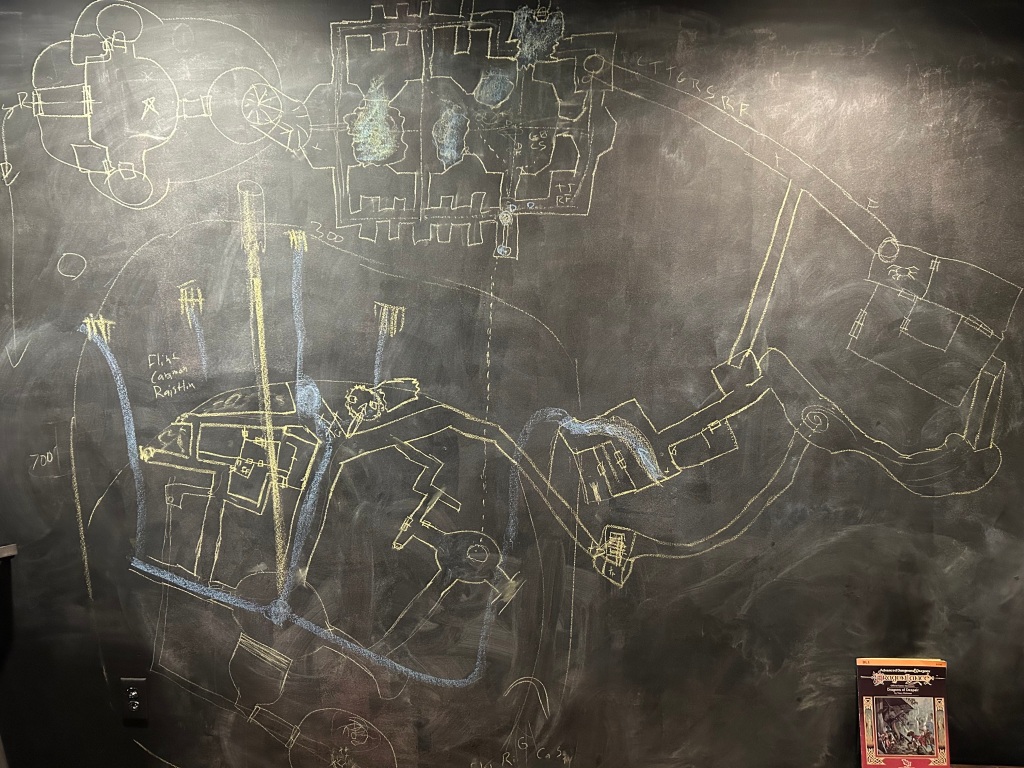
DL1 Dragons of Despair is a fun module…once you get past several pages of read-aloud text and aimless stage-setting. One option is to skip directly to page 8: Council Hall of the Highseekers. Get right to a meaningful decision for the PCs…
What path will you take to the Lost City of Xak Tsaroth? An overland route through the forbidden Darkenwood and across enemy-infested plains? Or a boat path through a raging river canyon and along an unknown sea coast?
Another option is skip to page 13. Go straight to the jungle of the lost city. Fight your way through vines and swamp things and draconians on log bridges. Discover the sunken city ruins and the temple of a forgotten goddess, with ominous stairs leading down.
The point is to get to the strongest part of the module: the dungeon…a subterranean lost city with classic pulp adventure features and an engaging map. It’s not a large or particularly complex environment, but it took us four sessions to complete. There’s just a lot to do and ways to do it.
There are several elements that aren’t elaborated upon in the module but, in our game, they played a big part of the dungeon action. Modern modules often cover these topics more directly, but older modules like this tend to leave things unstated for DMs to work out on their own. In any case, it helps to be prepared…
Faction play with Gully Dwarves.
Allying with the “bad guy” draconians isn’t probable, but it’s not assumed that PCs will work with the gully dwarves for mutual benefit. The module doesn’t give advice to the DM for how that relationship may play out. The descriptions of gully dwarf behavior implies that it would be like allying with a cross between Ewoks and hamsters.

In our game, the party did align with the little guys. The PCs kicked draconian ass early and often, earning gully dwarf respect and confidence. In turn, they helped the party as guides, spies, elevator operators, guards, alarms, decoys, etc. Despite being something of a comic relief element, the gullies can be a critical and valuable part of the adventure.
Where to rest and reload?
Chances are the party will want to rest, heal, and refresh spells while down in the lost city. They’ll need a safe haven or hideout. Again, not something the module mentions at all, but there are at least a few options for this:
In the gully dwarf district. In our game, a couple PCs had been seriously injured by poisonous snakes. They befriended Gully King Highbulp, who then offered a protected room for the PCs to recover.
At the upside down inn. The PCs rested here one night on their initial descent after the gullies assured them it was safe, primarily to re-memorize and swap in new spells. It’s located on a sub-level at mid-elevation, somewhat out of the way to return to if needed.
Recharge the crystal staff at the goddess statue. The staff has great healing powers (and more), but needs to be recharged at the temple. This is at the surface of the lost city, which presents a minor challenge to get up there and back, safely and stealthily.
In our game, the PCs returned twice to recharge the staff. Usage of the chain elevator became a fun focal point of the adventure, and here the gully dwarves were of great help to the party. Eventually the PCs learned how to use the treasury teleports for a less hairy and harrowing journey up and down.

How do the Draconians respond?
Hopefully the PCs are tactful about killing the enemy. Sooner or later the garrison of draconians will discover their numbers are decreasing and do something about it.
In our game, the PCs WERE tactful and never let a draconian escape from battle. Thus, the surviving garrison was unaware of the party. Instead, they suspected the gully dwarves were behind the killings and responded by raiding Gully King Highbulp’s district.
This occurred while the PCs were up top, recharging the crystal staff. When they came back down, the place was crawling with draconian soldiers. The endgame had begun.
To scroll or not to scroll?
In the goddess temple near the dungeon entrance there’s an encounter that will likely result in the party acquiring a magic user scroll holding a 10th level Lightning Bolt spell. A nice weapon for a party of level 3-6 PCs.
Thing is…using the pre-made characters and by-the-book 1E AD&D rules, the party can’t read or use the scroll during the adventure. This Raistlin doesn’t have Read Magic in his spellbook! Probably an editorial oversight. In later modules of the Dragonlance series, Raistlin does have Read Magic.
In our game, we decided Raistlin could use the scroll. It made the sickly mage more useful and worth protecting. That lightning bolt ended up being the killing blow against the final boss dragon. Fried to a crisp by a little crackling fork of electricity.
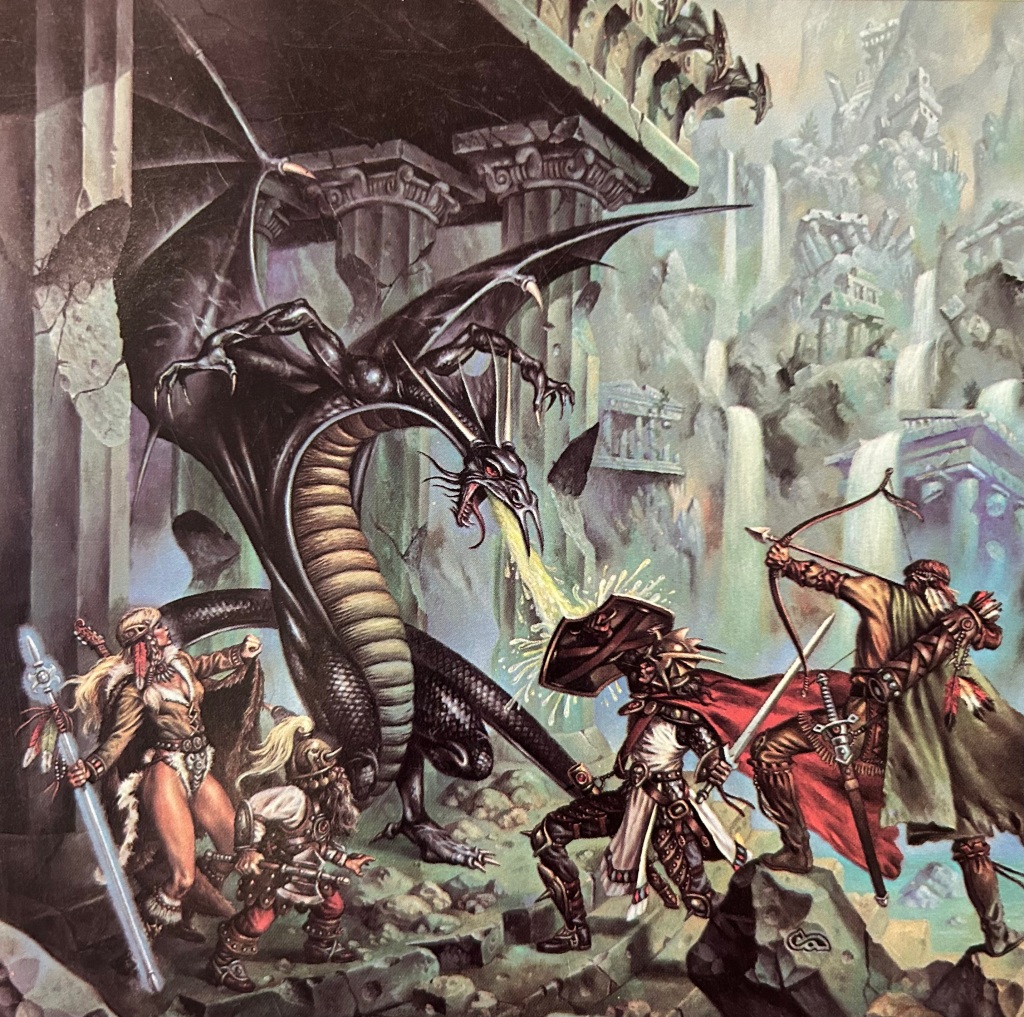
Arduin: The Caverns Beneath the Forgotten Tower
January 25, 2024

My brother and I played the sample dungeon in The Arduin Adventure rulebook. There’s a few suggested encounters, but it’s mostly a blank canvas “to allow the GM a chance to practice doing this himself.” Challenge accepted. The map of the caverns beneath the Forgotten Tower is in the wonderful classic Hargrave style: full of secret doors, nooks, crannies, secret doors, twists, turns, and secret doors.
I heavily altered the map. This was our first time playing Arduin and we wanted to focus on evaluating the combat rules, instead of getting bogged down in mapping and graph paper bitching. So I eliminated most secret areas and nooks and crannies. Really smoothed it out.
Then, I added verticality and water features. Pools, slides, dripping, waterfalls, rapids, fungus, fog, wet sand, mud, etc. There should be no doubt…this is a wet place. Probably inspired by The Goonies.
Also: natural stone stairs. I’ve always wanted to use them on a map ever since I saw the mapping symbols key in the red basic D&D book. Dream fulfilled.
Here’s what I ended up with, alterations in pencil:
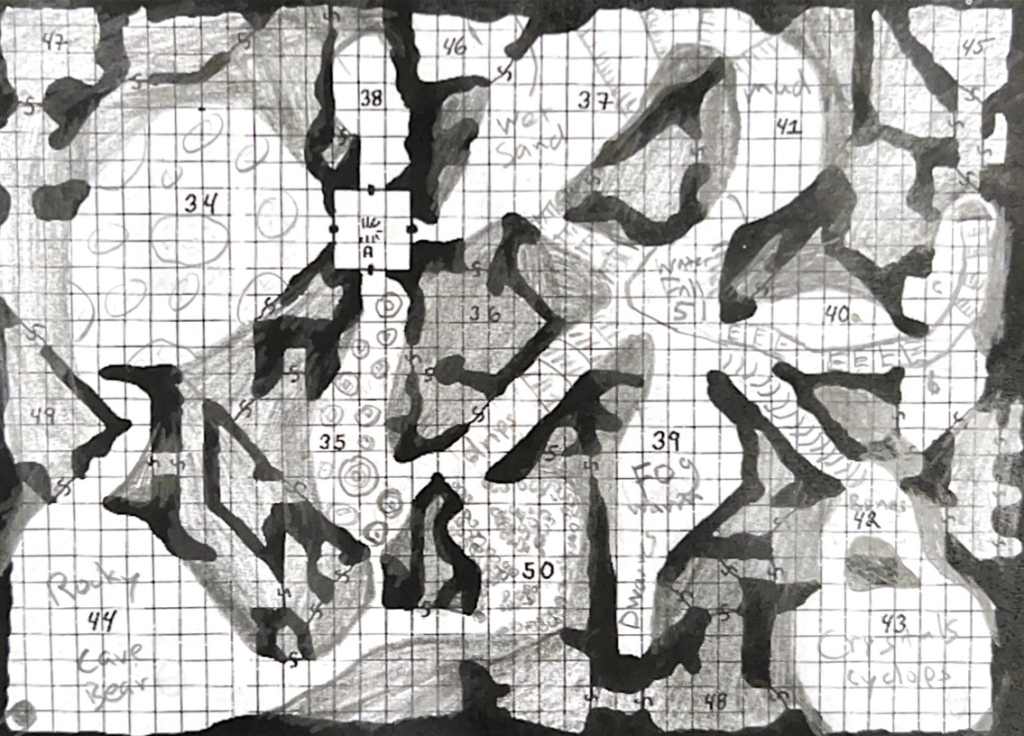
Game time. The stalwart adventurers, Gromm the Warrior and Robyn the Ranger entered the Forgotten Tower. A giant tarantula jumped them in the great hall, but escaped downstairs to the caverns. And so down down down the spiral stairs they went…
They passed through a cavern of large columnar formations connected floor to ceiling. Next a chamber bursting with fuzzy mushrooms and toxic spores. Then a slippery, drippy passage and a sloping floor…swoosh. Splash. Into a pool.
A waterfall also cascaded into the far side of the pool, which emptied out in a series of swift rapids. The ranger was swept away by the current, lost to depths unknown. The warrior boldly pursued, but his pal was nowhere to be found and the warrior found himself in a strange cave with a basalt altar. Blood grooves, moon and star etchings, and nearby embedded in the stone wall: an irregular metal blob, giving eldritch vibes.
The warrior wanted no part of it so he backtracked and entered a side passage enshrouded in fog. A haggard voice called out “Stop there foul beast!” It was Cragor, leader of a decimated party of dwarves. They took heavy losses from a battle with a cyclops deeper in the caves before retreating to this hidden passage to regroup. They sure could use the warrior’s help in defeating the cyclops and claiming its crystal lair.
Thus the adventure proceeded. The warrior and the dwarves went down natural stone stairs to an antechamber of skulls and bones. The cyclop’s lair was just beyond, so the raiders made a plan of attack.
The warrior and dwarves charged around the corners and the cyclops roared awake, its huge glowing eye illuminating the amethyst dome of his geode lair. A great battle ensued and they were victorious.
The dwarves began mining the crystals immediately. The warrior helped. This went on for several hours. The dwarven leader had a bottomless barrel that would hold all that was mined for easy transport. He then gave the warrior a small portion of amethyst and thanked him.
The warrior asked for a larger share. An argument began and it came to blows. In the end, the warrior had slain all the dwarves and claimed all the loot for himself. He left the caverns below the Forgotten Tower and returned to Shadizar. There he cleaned up and purchased new clothes. Indeed, a very fine ensemble of new clothes.
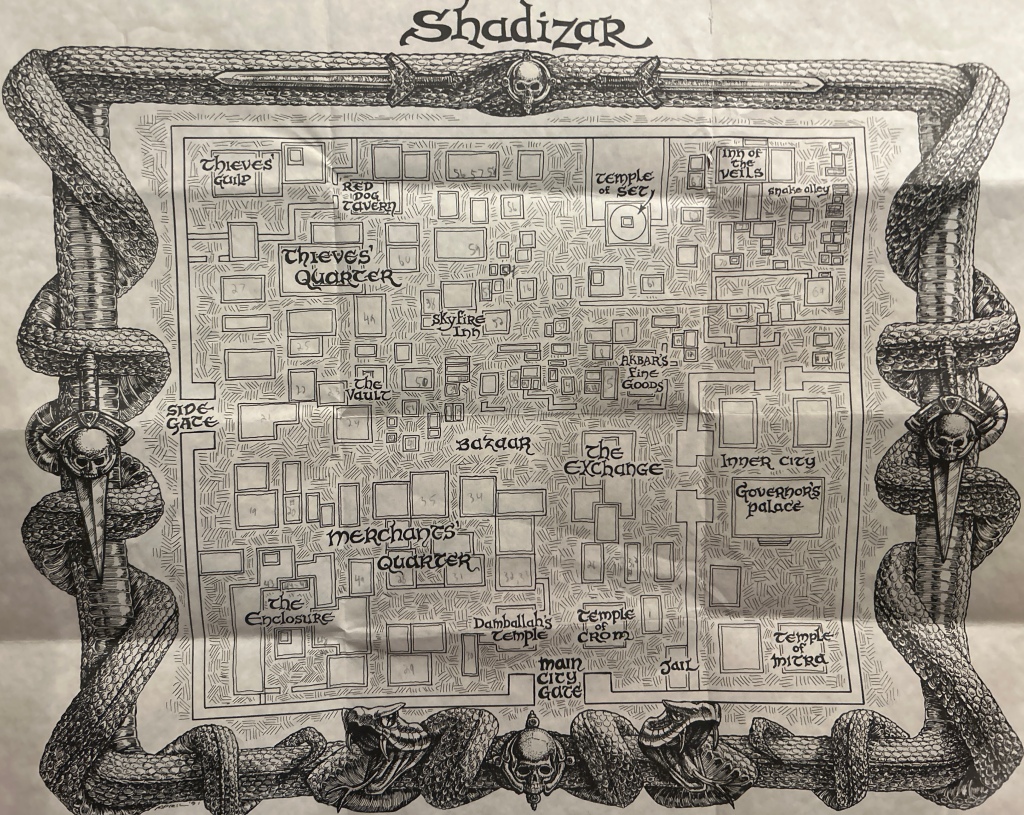
DL8 Dragons of War: The Megadungeon Experience (Part 2)
January 17, 2024
In part 1, I looked at how I prepared to run DL8 Dragons of War, focusing on the complex structure of the castle and the compelling treasures within. Here in part 2, I recount our actual play and call out the best and worst parts. Did my prep work bear fruit?
We played the module over three sessions…
Session 1
Whereas I6 Ravenloft has 8 pages describing the realm around the castle and fortune-telling to determine the goal artifacts and locations, DL8 has 8 pages of choose-your-path entries to accomplish the same.
Whatever. It’s long-winded but works okay for its purpose. Most Dragonlance modules only pretend to give freedom of choice in the journey to the primary adventure site, so at least DL8 doesn’t pretend. Or the entire thing can be skipped, and the DM states: “You arrive at the castle after X days and these are the goal artifacts and their rumored locations.”
In our game, the journey determined that the goal artifacts were the Crown of Yarus and the Codex Orbum. The pieces of the crown were in the High Clerist’s personal chamber and the Altar of the Orb. The Codex was at The Nest…the pinnacle of the castle tower.
The PCs arrived at the castle and had opportunity to learn rumors and lore by mingling with the mercenaries and refugees camped outside. Then they met the Solamnic Knights preparing to defend the castle against the approaching dragon army. The knights described the situation and status of the garrison. Yada yada yada. The important thing was for the PCs to learn about the major routes into the castle interior, as described in part 1.
The PCs choose to take the gallery stairs, as it sounded like the best bet for getting high into the tower as fast as possible. Quickly up they went, and we ended the session when they reached the Hall of Mirrors on level 5. The results of this session would guide my prep for the next, big session.
Session 2
To facilitate consistent pace in this session, we used both regular dungeon exploration and sparse exploration pacing. In practice, this involves the players declaring their general direction, mode, and goal of exploration. The DM then describes the route and destination, as well as any interruptions or discoveries along the way.
This technique worked well for areas where I had cut some of the more repetitive encounters (“sparse areas”), and we flowed freely back to regular dungeon exploration procedure when it seemed appropriate. No precision mapping was done, but some parts were sketched out on a large blackboard as the party moved through. Also, the party’s location in (x,y,z) space was casually tracked on the top down view of the castle:
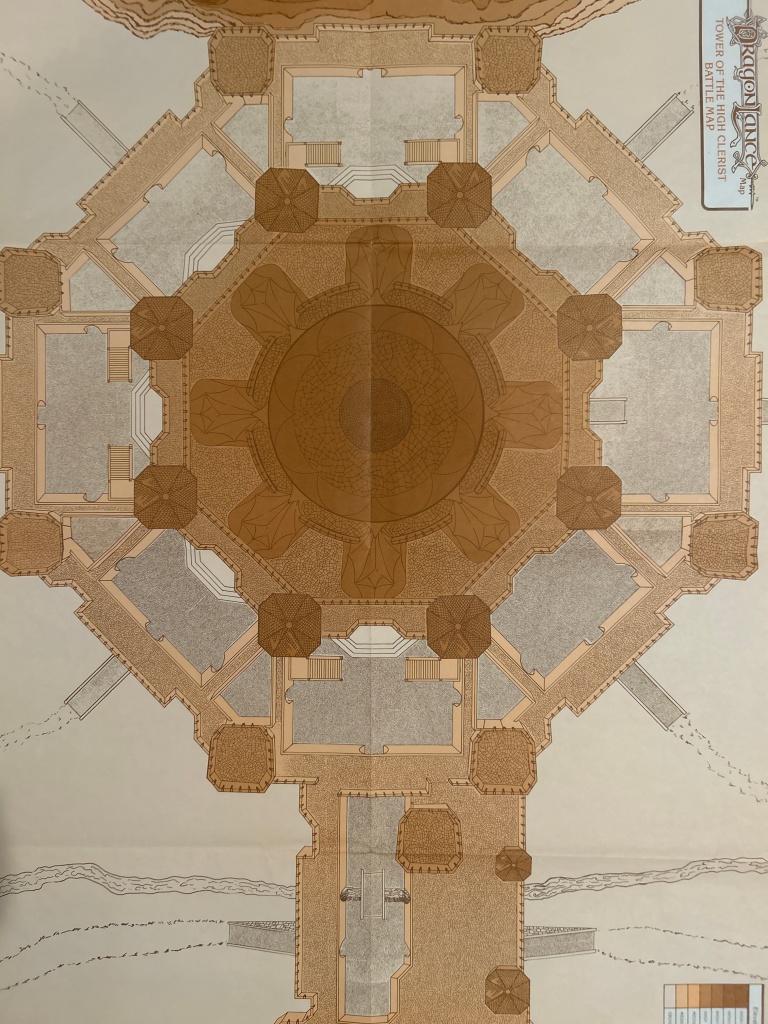
Level 5: Tasslehoff, being a kender and kender being curious, couldn’t resist looking into the mirrors. This awakened the Fetch, a wraith-like creature visible only in the mirror’s reflection. This is a fun encounter if one can stomach the possibility of level-draining. The module doesn’t mention it, but I think the PCs could break the mirrors, a la Conan the Destroyer, to defeat the Fetch and potentially open a shortcut to the Eternal Halls. In our game, the mirrors were not broken and Tasslehoff was drained of multiple levels before the party escaped upstairs.
Level 6: Through the garden terrace and into a massive portcullis chamber where the PCs observed spectral men and women in elegant revelry. They seemed oblivious to the party’s presence and so the PCs mingled through and up the grand staircase.
Level 7: The stairs opened up onto a balcony overlooking the ballroom revelry. Some of the spectral dancers below took notice of the PCs, which prompted the party to duck into a nearby dining room of notable opulence. A Solamnic Lockbox was there. Tasslehoff picked the lock and found a tome within: The Tales of Virkhus. They read about the High Clerist’s powerful ally and then proceeded into a great hall of tapestries, statues, and a spiral stair going up. They briefly investigated another gallery of statues before a banshee chased them away and up the spiral stair.
Level 8: The party had the option to continue up the stairs or stop to explore this level. They were about to continue up, but a Will-o-wisp shimmered and beckoned down the hall. The PCs obliged and eventually found their way to a large cathedral where the Book of Habbakuk shined on the altar. The spectral caretaker of the abbey completed a prayer, then greeted the party. He was sympathetic to their quest and he shared what he knew about the Crown of Yarus and Codex Orbum. The caretaker gave them a special key to open doors and lockboxes throughout the castle. He also revealed to them a special lockbox upon the altar. Within: three pale green prism Ioun stones.
More spectral minions, of the philosopher and evil searcher varieties, were encountered while exploring the abbey, then the PCs made their way back to the spiral stairs and up.
Levels 9 and 10: Skipped because they are exact copies of level 8. Boo. Your mileage may vary. Up up up to…
Level 11: The High Council Hall of Solamnic Knights. The Great Pillar of Yarus towered above the vast chamber with crystal windows all around, illuminating an assembly of seventy ethereal knights. They were at an impasse, trying to decide a complex case of the Oath and the Measure. One of the PCs, Sturm, though not yet a Knight, was recognized for his Solamnic ancestry and allowed to cast the deciding vote to break the impasse. In thanks, the Lord Knight gave Sturm clues to navigate the Eternal Halls to the Treasure Vault.*
Level 12: The fate of Lord High Clerist Yarus was discovered here: trapped under a pillar, 300 years ago, while playing the chess-like game of Khas. His ghost called for the return of his crown. A few rooms away, in Yarus’s private chamber, waited a vigilant dog spirit guarding a lockbox. The good boy beckoned the party to open it and within they found a minor fortune of gems and a piece of the broken Crown of Yarus. The faithful guardian then licked and scratched at a section of wall nearby, which opened to reveal a secret spiral staircase going up and down. The party went up and the dog spirit followed.
Level 13: A heavy portcullis blocked an entrance into the Eternal Halls. Unable to open it, the PCs moved on and found a lockbox containing a Potion of Polymorph Self, then continued up the stairs.
Level 14: The large central rotunda was the only way up to the next level. The guardian: twenty-tree evil spectral warriors. It’s one of the more climactic encounters in the tower but the text doesn’t really hint at that. To make it more interesting and manageable, I had them arriving in waves of d4+2 evil warriors, from all directions. When the battle was looking grim for the PCs, the spirit dog pounced in and turned the tide by securing a flank. The party prevailed after they hacked their way up the stairs and shot down at waves of pursuers. A satisfyingly epic battle. The party was low on health and spells, but continued up the stairs.
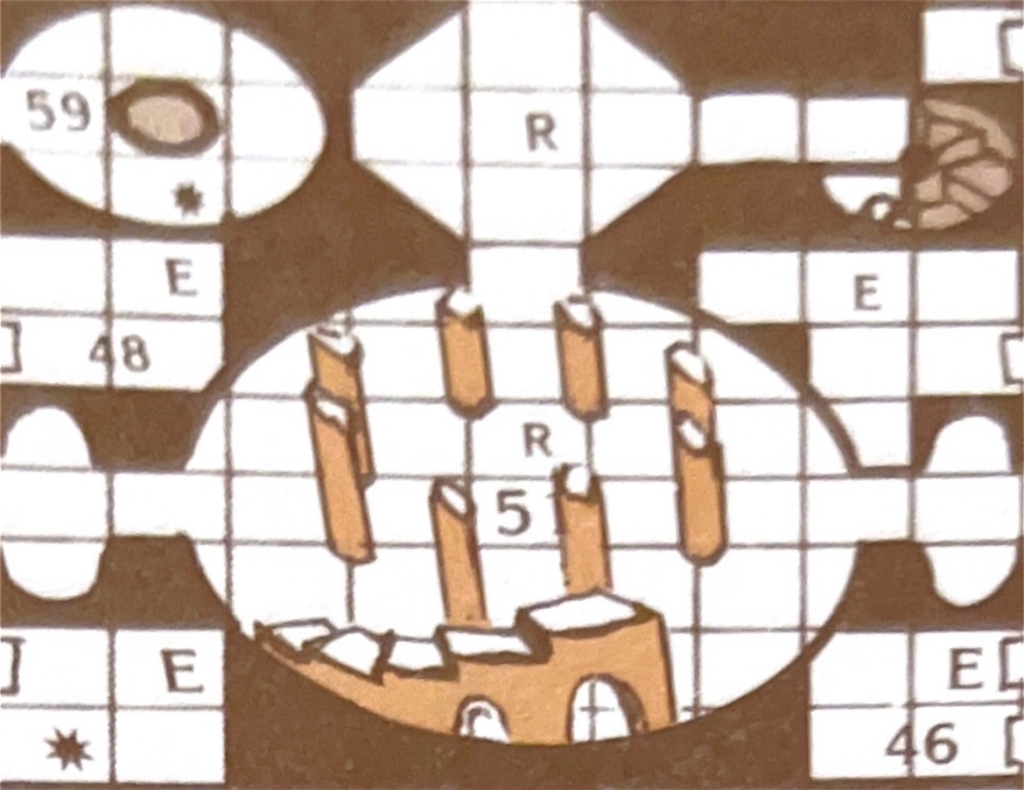
Level 15: The high paparet. From here the PCs observed the dragon army congregated 2 miles away, with an estimated strength of 2000 to 3000 men and monsters.
Level 16: The Nest. A giant owl spirit hooted when the PCs climbed up, then blinked large glowing eyes and turned its head toward a lockbox. The party opened it to find the Codex Orbum and a Ring of Invisibility. The owl took flight, soared high above, and the PCs heard its ghostly screech and telepathic voice: “The dragons are coming”
Session 3
The PCs returned and healed at the garrison stronghold and shared their findings with the Solamnic commanders. Study of the Codex Orbum commenced.
On their next mission into the tower, the PCs took the secret stairs down to the Altar of the Orb. Another lockbox was found, containing a Wand of Wonder (93 charges) and the final piece of the Crown of Yarus.
The party promptly took the completed crown up to the High Clerist’s sanctuary and placed it upon the skull of Yarus. This released his spirit from its entrapment and allowed him to fulfill his vow to aid in the coming battle.
Meanwhile, with knowledge from the Codex, Sturm activated the Dragon Orb on the Altar. We used the “Dragon Orb of Mindweb” rules from DL12 to determine Sturm’s success in activating and controlling the Orb. He was able to harness the power of the orb without getting pulled in and the sanctum’s sealed doors flung open. The final battle had begun.
We opted to use the module’s “Simplified Battle Resolution“ system to determine the results of the final assault on the castle by the dragon army. The spirit of Yarus and the activated Dragon Orb lifted the Solamnic forces to victory and turned the tide against the forces of darkness.
The End
Overall, an ambitious module with ingredients to appeal to different play styles, but it requires some work by the DM. Understanding the castle’s layout and loot can give insight into how to best use it in your game. A “megadungeon experience” is but one possibility.
*The Eternal Hall clues provided in the module is wrong, by the way. I couldn’t find a way to make the directions work. Maybe it’s intentionally wrong? Or just a typo? There are other typos in the portal numbering. A shame because the Eternal Halls seem intended to be a core part of the module. Maybe they would be fun in play. Anybody try them?
Here’s a fixed clue for navigating the Eternal Halls: From the north portcullis entrance on level 13: Right, Ahead, Left, Ahead, Right, Ahead, Right, Speak “sword, rose, crown” and enter the Treasure Vault.
DL8 Dragons of War: The Megadungeon Experience (Part 1)
January 16, 2024
We like castles. DL8 Dragons of War has one of the largest castles I’ve seen in a module, so we played it.
I prepped for play with a “megadungeon experience” in mind. By this I mean that the PCs have an objective, make a plan, and intrepidly enter a HUGE dungeon-like environment full of the unknown and wondrous. Then, far into the castle, as health and resources dwindle, make bold decisions about whether to press on or turn back. All within a session or two.
The rest of this post looks at the castle’s structure and treasures and how to bend them in service of a castle crawling session to the top of the tower.
Part 2 is the actual play report.

DL8’s Tower of the High Clerist
A true megadungeon experience is built up over an extended campaign, rather than a few sessions, but DL8 Dragons of War (1985) is an interesting module. Its castle certainly has the real estate to hint at megadungeon possibilities. It also has some features that set it apart from the rest of the DL series of Dragonlance modules and invite the module to be used in different ways. Consider:
DL8’s sixteen level castle (aka Tower of the High Clerist, map below) is one of the single largest mapped dungeoncrawl environments published by TSR in the 70s and 80s. Maybe thee largest. It wasn’t until WGR1 Greyhawk Ruins (1990) and The Ruins of Undermountain (1991) that TSR made dungeons definitively larger than DL8.*
In some ways DL8 is a successor to I6 Ravenloft (1983). Both are by Tracy and Laura Hickman and have isometric castle maps that are complex and believable.** Both utilize randomized locations of “goal artifacts”. DL8 is just so much bigger.
DL8 manages to describe a megadungeon worth of castle in less than fifteen pages. Several of the more important rooms have detailed descriptions, but many others exhibit Tegel Manor-like terseness and are reused throughout the castle. The module as written can support an extended campaign of dungeon crawling, interspersed with sessions of NPC interaction, war zone scouting/special ops, and mass combat. Or, the DM can opt for a more focused scenario, trimming repetitive parts and focusing on the best parts.
Yes…DL8 has a mass combat war element. It’s optional, in the sense that DM and players can emphasize and engage in the mass combat stuff to fit their preference. The module has a single die roll “Simplified Battle Resolution“ system for mass combat. It also contains rosters and stats for using TSR’s BattleSystem miniatures rules. Either way, the war element gives the module a Siege of Gondor vibe with time pressure. This may push adventurers to adopt an aggressive or stealthy style of castle exploration. The layout of the castle supports this.
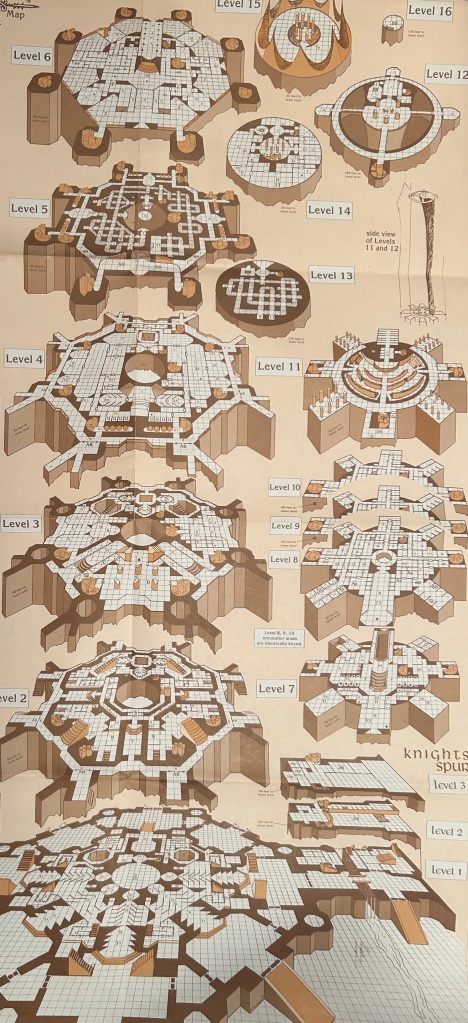
Understand the Castle
The poster map of the castle is impressive and detailed, but its “big picture” layout isn’t obvious or explained in the module. Such as: avenues of ingress, connections between the sixteen levels, choke points, and areas with secret access. Understanding these were key to prepping to run DL8. Here’s a start:
Levels 1-7: the lower castle. Temples, servants, and quarters mostly. With the Altar of the Orb and the Treasure Vault secure in its core. Much loot is scattered about these levels, but also traps and defensive works.
Levels 8-12: the middle tower. The abbey, knight’s council, and the High Clerist’s lofty abode. Interesting set pieces.
Levels 13-16: the high tower. Restricted access. The only way to get up here is via a secret stair or slender shaft that run nearly the entire height of the tower.
A couple other important areas that have limited access:
The Altar of the Orb: Shut behind impossibly sealed doors on level 1. The only way in is to come from above: via that secret stair/shaft, or down a yawning abyss from the Treasure Vault on level 5.
The Treasure Vault: The only ways in are via the vexing Eternal Halls, or up the yawning abyss from the Altar of the Orb on level 1.
Four ways to get deep up into the castle tower:
- Up the long gallery stairs on level 2. If the party doesn’t snoop around much, these stairs are a fast track to level 7. Assuming the garden portcullis on level 6 is or can be opened.
- Beyond the temples on level 2 there are numerous stairs going up. With some exploration on subsequent levels, the party will eventually arrive to level 7. This route has many opportunities for finding loot and secret shortcuts, at the cost of more encounters and traps.
- Up the supply shaft on the north side of level 1, directly to level 4. This shortcut has its own dangers, but also opportunities to discover other secrets.
- A party could try to climb the outside of the castle, ideally with the help of a thief or magic. There are windows and balconies that can allow entry on many levels.
The castle’s Solamnic Knight garrison never ventures beyond the outer fringes of the interior, for it is haunted and sacred to them. But…they are likely aware of these four main paths up the tower and it’s good intel to share with the PCs to help them plan their missions within.
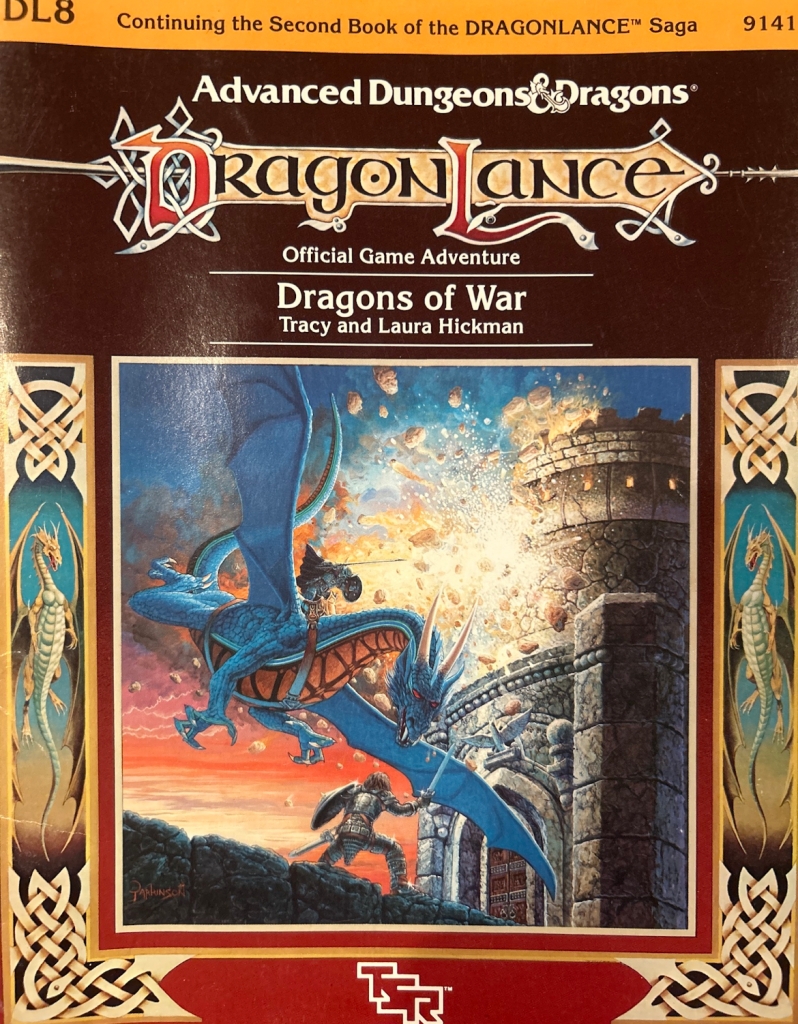
Understand the Loot
Apart from the Treasure Vault in the middle tower, the vast riches of the castle is spread throughout, randomized by drawing from a deck of regular playing cards. The chart of potential treasures is marvelous: Holy Avenger Sword +5, Book of Exalted Deeds, Wand of Mass Flying, coins and gems galore, and much more.
To add a little flavor, I placed these treasures in Solamnic Lockboxes. Ornate, sturdy and seldom trapped, they are very difficult to smash open, but can be lock-picked. Each discovery and opening of a lockbox was a moment of excitement and surprise. Draw a card!
One of the goal artifacts in DL8 is the Dragon Orb. I changed this to be the Codex Orbum instead. Studying the Codex would allow the PCs to learn the lore of the dangerous Orb, its powers and usage, in a more interesting way than via scattered conversions with NPCs.
With some insight into the castle map and encounters, the DM may want to limit the potential locations of the goal artifacts. For example:
- There’s an area on level 14 with a large group of evil spectral warriors that guard the only stairs up. This would make a nice climactic and tactically interesting battle, so I decided to have a goal artifact on the top level. The party must find a way through or around these spectral warriors.
- The Eternal Halls are neat in concept, but I was concerned they would be more confusing than fun during actual play. Also, there are several typos in the map and text of the Halls. My preference was to not force the PCs there, so I eliminated the three options for placing goal artifacts in the Eternal Halls.

The module’s full-page art of befuddled heroes in the Eternal Halls.
*Compared to DL8 Dragons of War, the closest contenders for largest dungeon environments made by TSR in the 1970s/80s are S3 Expedition to the Barrier Peaks (1980) and T1-4 Temple of Elemental Evil (1985). A few more are contenders if their vast underground maps are included: D1-2 Descent into the Depths of the Earth (1978), B4 The Lost City (1982), and H2 The Mines of Bloodstone (1986). Any others?
**In Dragon magazine #155, a reader from Schenectady, NY notes:
“Also responding to the anonymous letter in issue #152 about the ineffectuality of castles in a campaign featuring magic and flying creatures, I agree. But I would like to point out that rather than abolishing castles, this situation just changes the way in which castles are built. The Tower of the High Clerist, in DRAGONLANCE module DL8 Dragons of War, is a good example of this. Almost fully roofed and magic resistant, it is highly defensible and protected. If this is not enough, the entire place is designed to stand even if every gate in the place is breached. It is a vast maze with huge numbers of magical and mundane traps and tricks. A small number of knights who knew the place could easily protect it against huge armies.”
I6 Ravenloft: Straight to the Castle
June 7, 2023
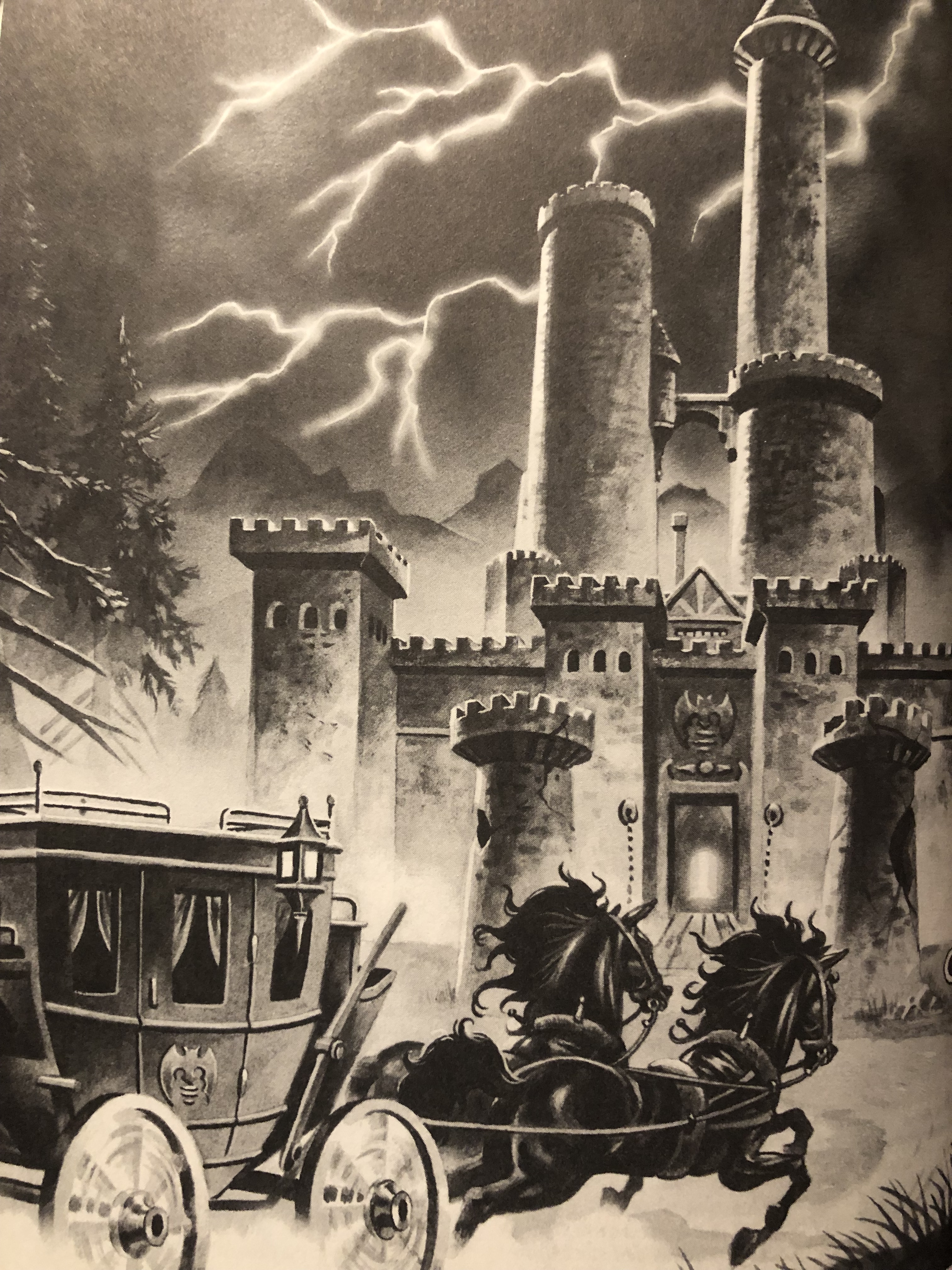 Earlier this year we played I6 Ravenloft using these three pre-gens from G1 Steading of the Hill Giant Chief:
Earlier this year we played I6 Ravenloft using these three pre-gens from G1 Steading of the Hill Giant Chief:
- Roaky, human, level 12 cleric
- Frush, human, level 14 fighter
- Fonkin, half elf, level 5 fighter / level 8 mage
The module recommends levels of 5-7. We choose to use overpowered PCs on the theory that they were seasoned vampire hunters. Thus, they may be able to cruise through the low level undead encounters and focus more on castle exploration.
I made these four clues/rumors that the party could acquire. And…they got all four:
- “The belfry’s greatest treasure rings not!”
- “Friend of mine once played a most enchanting card game with the Count. It seemed his very soul was the wager. After a run of good luck at the table, the iron guardians brutishly escorted him to the door.”
- “Strahd’s slimy green zombies are a special creation with unique powers. Chop them to hell!”
- A letter from Strahd’s accountant inquiring about a broken blade “of minor sentimental value” that the Count wishes to acquire. Ask for Mr. Lipsiege on the second floor.
I skipped the village and started the party in the black carriage, speeding towards the castle in a thunderstorm, getting their fortune read by an old woman. Straight to the action. We were curious how many gaming sessions it would take to complete the module with this setup.
The old woman flipped one more card:
“Here is a high and noble card. One of you carries a weapon that is stronger than any other against the evil in this land. Only one part is missing from this weapon. That part is found in the evil one’s castle.”
Session 1:
The vampire hunters stepped out of the carriage, into the rain and courtyard. They entered the main gate, followed the organ music and quickly encountered Strahd in the dining room. But it was just a reflection and he laughed in their face.
The party went upstairs and spoke to the count’s accountant about the sword “of minor sentimental value” that the Count is seeking. He, in turn, told them of a holy symbol downstairs in the mother’s crypt.
After easily turning some weights in the throne room, they went downstairs and defeated a pack of multiplying “Strahd Zombies” in the torture room, but took a hefty amount of damage.
Instead of graph paper, we mapped on a chalk board wall. Here’s the first session’s progress, about 25% of the castle:
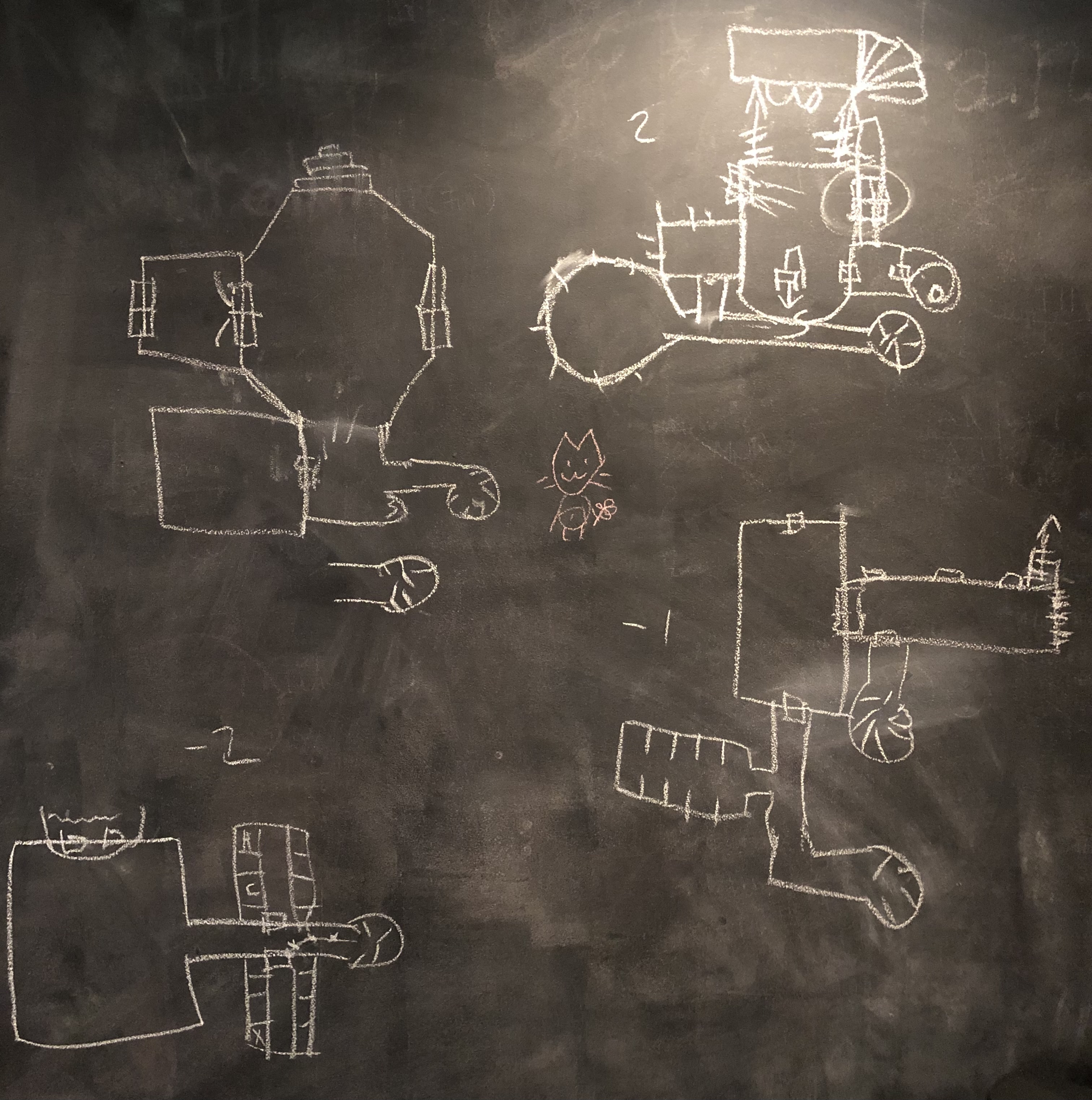
Session 2:
After the party defeated the slimy uber-zombies in the flooded torture chamber, they heard a slow clapping coming from the balcony. It was Strahd, applauding their victory.
The Count praised their combat prowess, especially the swordplay of the half-elf. Thus began a parley on the balcony in which the vampire hoped to take possession of said blade, suspecting it to be a component of the vampire-killing weapon: the Sunsword.
The fighter failed his save vs Strahd’s gaze charm. Thus began a tense moment where the fighter was about to give the sword to the Count. The cleric thought maybe the fighter was only pretending to be charmed, and was expecting the fighter to strike instead of handing over the sword.
At the last moment, the cleric realized that the fighter WAS actually charmed. And so the cleric boldly presented his holy symbol, causing Strahd to recoil temporarily. This, and the cleric’s pleading, helped convince the charmed fighter to resist the spell. The fighter made his saving throw to break the charm.
The half-elf cast a Web spell on Strahd, but the vampire broke through easily and responded by calling forth a pack of Worgs.
The fighter, free of Strahd’s charm, engaged in combat and was getting the best of the vampire. But then the Count struck to drain two energy levels from the fighter. Meanwhile, the cleric beat back the huge wolves best he could.
The half-elf, not wanting to risk any more level drain on the fighter, cast a fireball at close range on the balcony…hitting everybody. The vampire went gaseous to avoid a killing blow. Wolf hide was scorched. The fighter and cleric braced for the blast and avoided the worst of it. The spell caster himself was thrown from the balcony into the balls-deep water of the torture chamber and narrowly survived.
The vampire having been banished to its hidden coffin for eight hours to regenerate his corporal body, the party easily mopped up the remaining Worgs. The trio then healed up and entered a puzzle room with four locked exits, a blazing brazier, a golden chest, and two iron guardian statues.
After a brief but intense battle with the guardians, the party was able to open the center door and drag the heavy chest up a staircase to a hall. The chest’s lock was then sprung but so was a sleeping gas trap. The cleric and half-elf fell asleep for three hours. The fighter kept watch and continued to fiddle with the chest. A back door was found, granting access to the loot. Amongst the spoils was a Deck of Many Things.
Four and a half hours remaining to find the vampire’s crypt and kill it while still incapacitated.
Session 3:
Strahd lies vulnerable in his coffin, regenerating from last session’s fiery defeat. The PCs systematically explore the catacombs in search of the vampire lord, hoping to deliver the final, eternal blow. Disciplined and focused, they study and note the engravings thoroughly, but leave most crypts unopened. Wise.
The crude map we used for movement reference, the party’s path in dots:
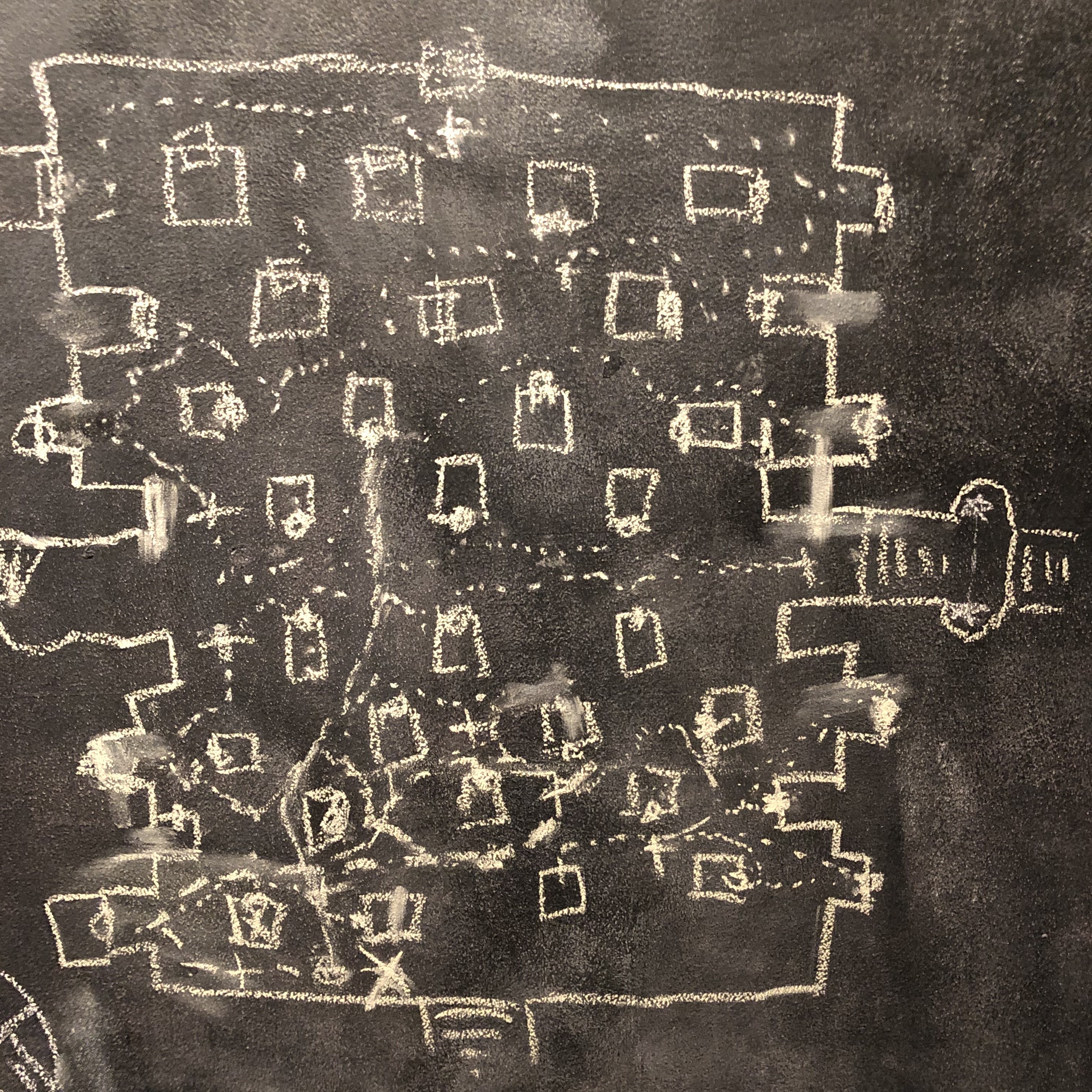
A teleport trap near the south crypt stairs splits the party into a battle against 15 wights. The PCs prevail and regroup, but the spiteful undead struck many level-draining blows before being banished to oblivion.
All this crypt searching took two hours of in-game time, and Strahd is still not found. Thus, two and a half hours remain until the Count revives.
Session 4:
The vampire hunters quickly resume the search for Strahd’s coffin. They determine that all paths leading to the south crypt stairs are guarded by teleportation effects. There must be another way.
Just to the north, one of the catacomb’s many silent crypts has a curious inscription above its door: St. Finderway, patron saint of lost traveler’s
The PCs push open the stone portal, into an empty crypt with two alcoves on the opposite wall. Above the alcoves is an engraving shrouded by cobwebs. They brush aside the dusty tendrils and read:
Pass not these portals ye foolish mortals!
They hear a group of footsteps approaching the from outside the crypt. The half-elf quickly enters the west portal…nothing happens. The cleric enters the east portal and vanishes, just as two men and a woman arrive at the door. They are very pale, wearing tuxedos and a ballroom gown, and declare:
“We came to the castle long ago to celebrate the royal wedding, and now we demand our satisfaction and destiny!”
…as they rush towards the PCs with fang and fingernail. The fighter and half-elf follow the cleric into the east alcove and are teleported away.
The trio now finds themselves in a stark crypt with a dirt floor and stairs going up. In the center is a shining coffin of waxed cherry wood and brass fittings. There’s little time to investigate, because the wedding guests have pursued through the teleportation alcove, and melee ensues.
The PCs are winning handily, but then realize that their foes are regenerating. The tide turns when the vampires strike level-draining attacks, so the PCs move into a more defensible position on the stairs.
The half-elf and fighter are exchanging blows with the enemy while, behind them, the cleric readies a spell…
Blade Barrier! A barrage of ringing weaponry engulfs the wedding guests at the base of the stairs. They vaporize in hope of achieving their long awaited satisfaction and a future RSVP.
The PCs wait for the blades to dissipate, and then, with a Prayer and a Blessing, they go back down into the dirt crypt. The brass clasps are easily undone and the coffin is opened. There lies Strahd in defenseless repose.
They drive a stake into the Count’s heart and lop off his head with the very blade that he so desired. Blood streams from the head in unnatural volume as the hunters hold it up in triumph. Strahd’s eyes and mouth are agape, and promptly stuffed with communion wafers. The vampire’s eternal struggle is over.
The Short List of 1970s Fantasy Movies
April 18, 2023
Precursors and progenitors to The Big List of 1980s Barbarian & Fantasy Movies, which I’ve updated, refreshed, and reorganized for the first time in a decade.
Harryhausen fantasy nights…
- The Golden Voyage of Sinbad (1973) This sequel to The 7th Voyage of Sinbad (1958) initiated a wave of fantasy movies leading up to the 80s
- Sinbad and the Eye of the Tiger (1977) More polished and underrated compared to Golden Voyage. These two had a pulp vibe and are the strongest progenitors of the 80s fantasy cinema deluge.
Fantastical sci-fi…
- Fantastic Planet (1973). French. Animated. Sci-fi but otherworldly to a fantastical degree.
- Zardoz (1974). Has a classic fantasy connection and Connery’s character is a barbarianish.
- Star Wars (1977)
- Star Wars Holiday Special (1978).
Robin Hood was here…
- Robin Hood (1973). Disney. Animated
- The Legend of Robin Hood (1975) BBC TV
- Robin and Marian (1976). Audrey Hepburn
Edgar Rice Burroughs trilogy……
- Land That Time Forgot (1974). Submarine drama becomes dinosaur creature feature.
- At the Earth’s Core (1976). Interesting underworld monsters and faction rivalry, but the unrelenting firelight color tones, exploding rocks, and grating dialogue requires one to be in a rare mood to enjoy.
- People That Time Forgot (1977). Rescue mission to the Mountain of Skulls where the green skinned Kurtz-type holds the volcano throne of the degenerate samurai tribe.
Terry Gilliam’s medieval comedies…
- Monty Python and the Holy Grail (1975). Oft quoted buffoonery.
- Jabberwocky (1977). Kinda like Predator but with castles and peasants.
Others…
- The Norseman (1978). Vikings and their wizard soothsayer go to the new world on a rescue mission against the natives.
- Circle of Iron (1978). Barbarian-type goes on martial arts quest of self-discovery inspired by Bruce Lee.
- Warlords of Atlantis (1978)
- Arabian Adventure (1979)
- Nosferatu the Vampyre (1979). Castles and Klaus Kinski.
Love or hate them, the Bakshi and Rankin/Bass animated fantasies closed out the decade with imaginative momentum…
- Wizards (1977) Post apocalypse science fantasy fever dream.
- The Hobbit (1977) Captures the spirit of the book.
- Lord of the Rings (1978) Basically unfinished.
- The Return of the King (1980) A 70s product in every way except the final release date. Get past the 10 minutes of convoluted intro and it’s a decent retelling.
The Heart is a Jungle
April 26, 2015
Dear friends. How long has it been since I’ve written? Things have changed. I’ve been so busy.
But I still heart jungles.
I spent a few weeks in the Philippines recently. Then I came home and re-discoverd the maps I drew for my jungle books. Presto! A new post.
I just wanna look in there…
Here is the first version of the Fire in the Jungle map. My initial idea combined regular jungle, dark jungle, and apocalypse jungle into a single map…
Later, I decided to move the dark jungle and apocalypse jungle ideas mostly out of the initial campaign area, to develop them separately with different styles and themes. Here’s a later version of the original Fire in the Jungle map in pencil…
Mostly similar to the final map. Looking back, I like the shaded mountains in the that version better, compared to the icon style mountains in the published map…
A short jungle interlude. That’s me in the green shirt, participating in a wet t-shirt contest, in a river, under the jungle. The woman in pink dominated…
There were numerous steps in creating the Tomb of the Monkey God map. First, I worked it all out in pencil, with lots of erasing along the way (right map). Then I traced it in ink with the help of a stencil. Finally, it was scanned, tweaked, and colored digitally to produce the final map…
Roadtripping in northeast Mindanao, Philippines…
The map in Jungle Castle Rock Apocalypse is based on northeast Mindanao, then flipped horizontally. I’m so clever. I sketched out a pile of topographic maps. An early version…
A couple versions later I experimented with a broader floodplain and steeper mountains…
Until finally settling on a more balanced version…
Another picture from the road. This mountain valley area is probably the closest I’ve ever been to actual wild and crazy jungle-jungle. This is actually the primary “highway” along the eastern Surigao coast…
I visited Corregidor Island! A primary inspiration for Jungle Castle Rock Apocalypse. The book’s cover photo is the entrance to Malinta Tunnel in 1945…
Here is that entrance in 2015…
The Tunnels Under the Rock map is the Malinta Tunnel map repeated ad infinitum reductio ad absurdum lorem ipsum…
The actual Malinta Tunnel goes all the way through the mountain, with numerous side passages…
Watch out for Rebar Hulks…
And Rebar Trolls…
The Castle on the Rock map is a mashup of ruined buildings found on Corregidor. The original penciled map…
GIMP is your friend…
Visuals…
Physical graffiti…
Da big gunz…
I just wanna look in there…
I just wanna go down there…
A man’s home is his castle…in the jungle…
ROBOT HAPPY MUTANT APOCALYPSE by Calum M
March 1, 2014
Still, it would seem, I live after an eternity of darkness and madness in the flier, of death and winter in the world outside. During that time, I have not written in the log; and I know not what obscure impulse prompts me to resume a practice so irrational and futile.
– Master of the Asteroid
Somebody read Clark Ashton Smith in quantity this winter. It makes me want to write, but don’t worry…I’m not planning to resume blogging on a regular basis! I just wanted to provide some linkage to Calum’s neato play reports of Clown Robot Doctor Apocalypse reskinned:
Magic Item and Treasure Appendix
Excerpts:
The characters are baffled by the tan and beige walls, the soft back-lighting, the constant hum of machinery in the background, and the unusual corridors which are comprised of moving floors (travelators and escalators), stairs, ladders and one person lifts. Some experimentation is needed to operate the lifts,but before long they can at least get them to go up and down by thinking about it.
…
Once we were all inside a ‘schlupping’ sound came from behind us. We turned to see the brown mud forming into a mound about four feet high, with a bright yellow ‘eye’ forming at the top. The eye brightened and a keening whine rose before a blindingly bright energy bolt ripped from what we have dubbed the ‘poo monster’ which seared the Elf’s flesh from his skull.
…
When we got back up to the entry chamber the exit door was closed. A panel slid back in the wall revealing a smallish god’s eye that had a red symbol of a box with an eye in it on a black background; Neither Pelgost nor Fokus knew of any orbital god fitting the description. It appeared to be looking right at us. A machine like voice told us that it was ‘The Computer’ and it was dedicated to our happiness, encouraging us to stay. It also informed us not to leave the chamber, relating that a public management platoon had been dispatched to ensure a joyful and seamless orientation and induction into the happy halls of Alpha Complex.
My daughter drew this robot:
